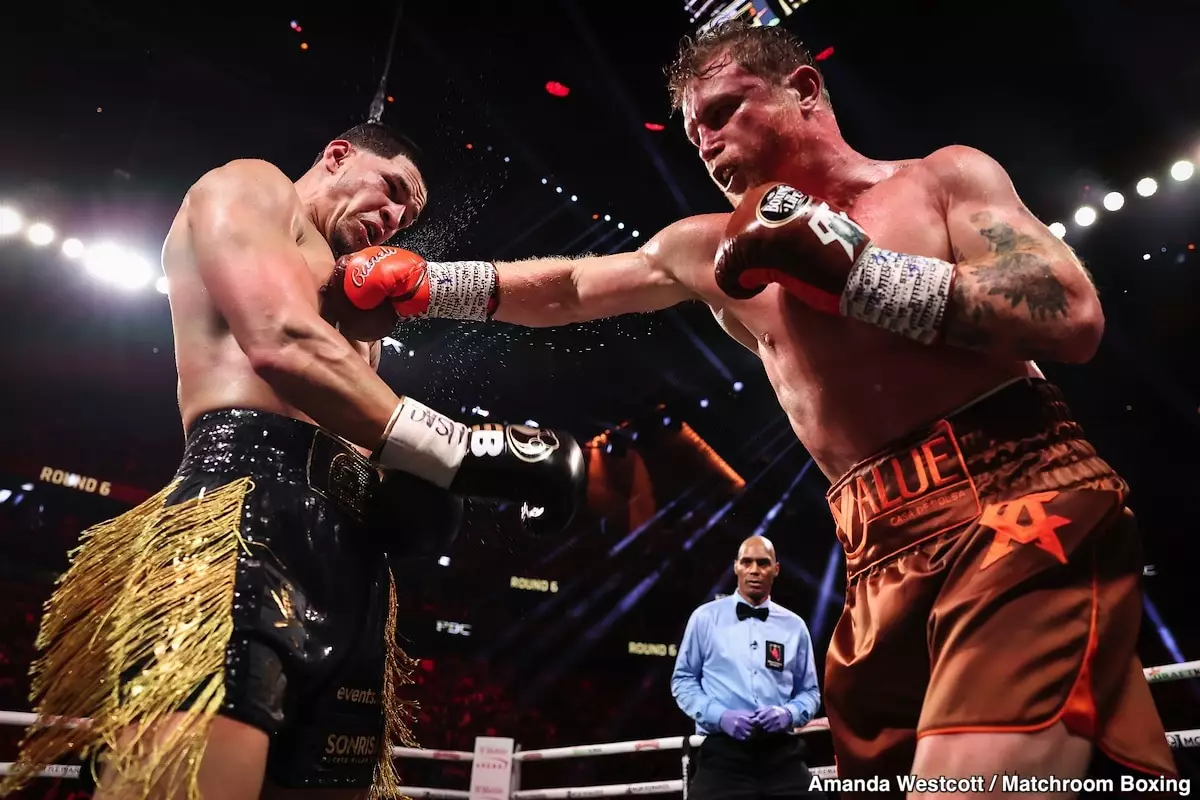BY BOXING HIT STAFF-
Canelo Alvarez, a name synonymous with boxing stardom, recently faced criticism from none other than Oscar De La Hoya. During a segment dubbed ‘Clap Back Thursdays,’ De La Hoya addressed the aftermath of Alvarez’s bout against Edgar Berlanga at the T-Mobile Arena in Las Vegas, prompting a discussion about the shifting standards in the boxing world. De La Hoya’s remarks ignited a broader conversation about fan expectations, fighter mentality, and the matchups that define the sport.
Boxing’s Attendance Issue: A Sign of Discontent
De La Hoya gleefully highlighted a significant concern — the lack of a sold-out crowd at the T-Mobile Arena during the Canelo-Berlanga fight. He noted that an entire section of the arena was curtained off, which he interpreted as a failure of the promotion and a reflection of waning public interest in what should have been a marquee matchup. The lack of a full house raises questions about the present draw of boxing’s biggest stars and whether the audience feels that their investment in witnessing these fights aligns with the caliber they are promised. In essence, it signals a discontent with the level of showmanship and competitive spirit being delivered.
Performance Analysis: Is Canelo Fading?
Canelo’s inability to secure a knockout against a much larger Berlanga has drawn ire and concern, particularly from De La Hoya, who observed that Canelo’s performance was far from electric. While Alvarez (62-2-2, 39 KOs) is undoubtedly a skilled fighter, many felt he could not break through Berlanga’s defenses despite landing powerful shots. This naturally leads to apprehension — is Alvarez’s performance indicative of a larger trend, or is it just a singular bout against an awkward matchup? The contrast between the action seen in Canelo’s past fights and this recent outing raises questions about his current abilities and strategies, especially in a fight where he was expected to shine.
The Problem with Matchmaking
One of the stark criticisms leveled by De La Hoya was aimed at the matchmaking decisions surrounding Canelo. Instead of opting for high-stakes bouts against formidable foes—like David Benavidez or Dmitry Bivol—Canelo chose to face Berlanga, a fighter with a questionable resume and a tendency to ‘survive’ rather than compete actively. De La Hoya’s frustration centers on a broader issue in boxing, where the choices made by promoters and fighters alike can dilute the excitement and prestige associated with the sport. Fans crave matchups that test the limits of competitors and deliver the raw intensity that defined the golden eras of boxing.
Reflecting on the fighter ethos, De La Hoya argues that today’s fighters have settled for participation trophies instead of seeking greatness. He lamented the fact that fighters are now being praised simply for lasting the distance against opponents who are not in their prime. This deviation from the warrior mentality that fueled previous generations begs the question: is the appetite for knockouts diminishing, or are fighters simply conforming to a more cautious style? De La Hoya thrusts himself into this debate, citing his own past battles where success wrestled with the inherent risks of the sport. His point underscores a disconnection between what contemporary boxing fans desire versus what is being delivered.
The notion that Canelo is more concerned with his legacy and financial security than with challenging himself against the best highlights a potential crossroads for the boxing community. De La Hoya’s candid remarks prompt fans and analysts alike to consider the implications of a champion who opts for less risky, more lucrative fights. As boxing navigates an era rich with talent yet seemingly content with less-than-stellar matchups, the future remains to be seen. Will fighters rise to embrace the mantle of champions, or will they continue down a path of self-preservation at the expense of their legacies?
The discourse initiated by Oscar De La Hoya regarding Canelo Alvarez’s recent fight and the current state of boxing goes beyond mere critique; it encapsulates a growing frustration among fans and former fighters over the evolving landscape of the sport. The wrestling with legacy, fierce competition, and true integrity in matchmaking fuels a desire for a return to excellence—a longing that, if left unaddressed, may render boxing a shadow of its former self. As the sport stands at this crossroads, essential questions about quality, competition, and the essence of boxing itself hang in the balance.


Leave a Reply